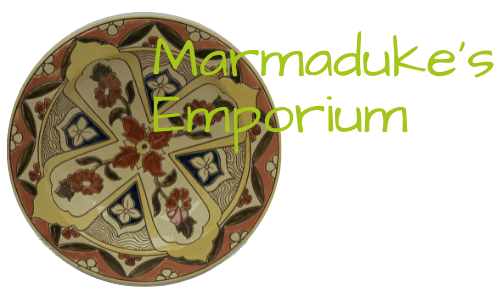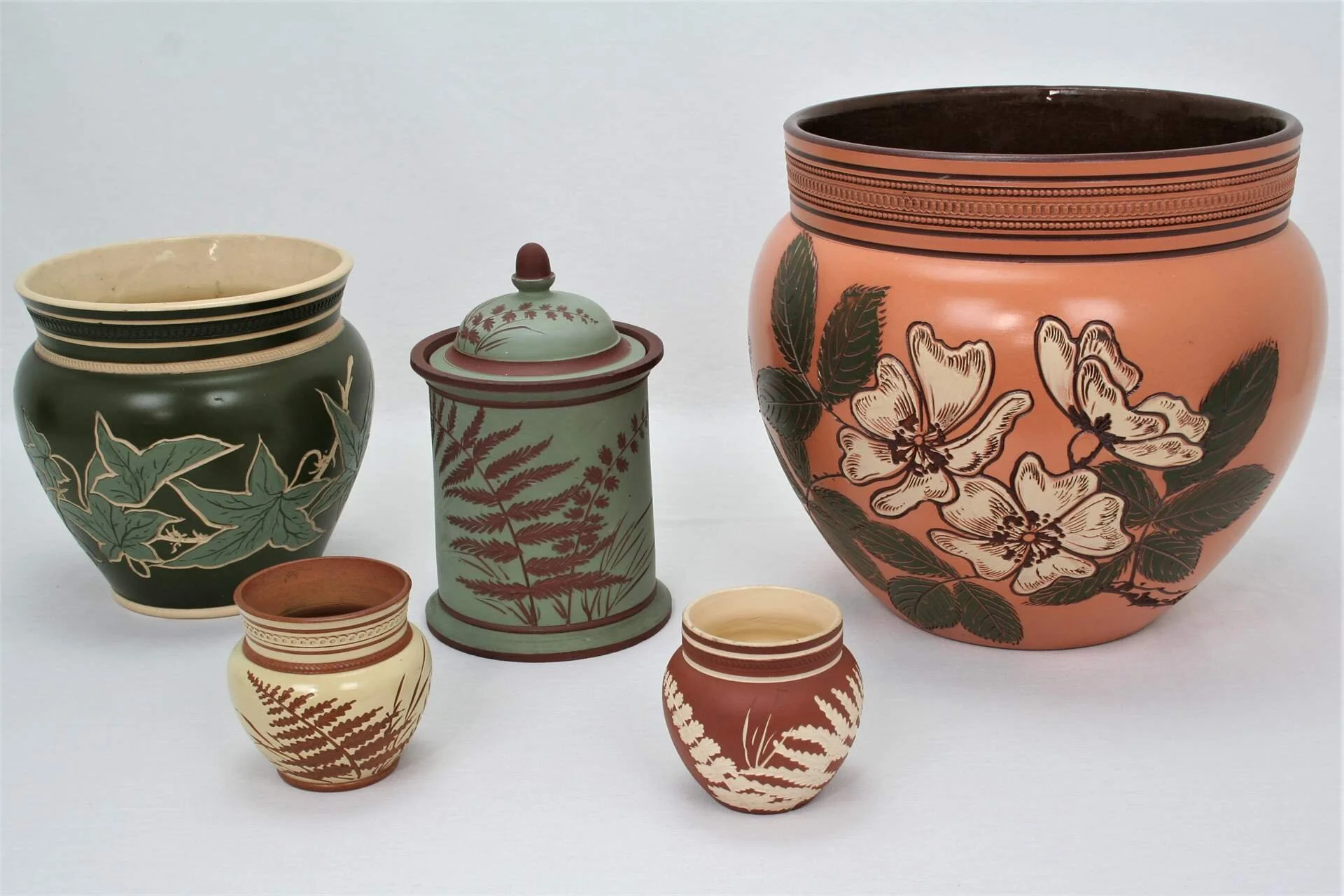
Art Pottery
There are three Shropshire companies that were involved with the Art Pottery Movement, Maw & Co., Craven Dunnill & Co., and the Benthall Pottery and whilst they all started fairly early on in the Movement, their stories are somewhat different.
A bit of Background
Small scale production of utility wares would have existed in Shropshire as it would elsewhere in the Country but with the abundance of raw materials and the first glimmers of the Industrial Revolution it was inevitable that the Severn Valley in particular would become a centre of pottery production. Its importance increased as the area flourished and whilst some firms soon disappeared after a few years and became lost to history, others became well established surviving into the 20th Century. To begin with the potters of Jackfield became well known for producing highly vitrified black glazed wares of good quality and whilst production didn’t last too long in the area any old pot with a black glaze to this day is known as Jackfield ware, even though it was made in Staffordshire, Scotland or Germany for that matter. It is difficult to identify genuine Jackfield ware as it wasn’t marked and rarely decorated but the body was of a dark red clay. Pottery production continued in Jackfield until eventually the site was taken over for encaustic tile production eventually becoming Craven Dunnill & Co in 1871.
Craven Dunnill (yes, Dunnill not Dunhill)
Not much is known about Craven Dunnill’s introduction into the World of Art Pottery but it seems likely that they started to decorate slip moulded blanks brought in from Foresters of Stoke in lustre patterns imitating Maw & Co. Their own work was in red clay and first covered in white slip and then with an attractive lustre glaze over the top in a range of colours. It is rarely decorated and none the worse for that and pieces are generally well marked.
Marmaduke’s Craven Dunnill Pottery
None of it is common but one of the most recognisable shapes is a hexagonal lidded vase which is a shape that Pilkington’s Lancastrian also used, shape 2800.
Craven Dunnill Moulded Vase with a beautiful turquoise lustre.
I think that it is fair to say that they lacked ambition and direction with the Art Pottery and it is assumed they ceased production in the 1920’s but they were very successful tile manufacturers and continued until 1951.
Maw & Co.
Born out of a fascination for medieval tiles they saw in churches, George and Arthur Maw bought a tile works in Worcester in 1850 but soon after decided that the Severn Valley in Shropshire with all the raw materials close at hand would be better suited and they established their Benthall Tile Works in 1852. The Maws were from a successful family, with good connections and so in the early years they were able to concentrate on development, establishing their name and they soon began winning awards and important commissions. They were well travelled and open to new ideas and by the 1870’s were producing vases in Indian, Moorish and classical styles in rich majolica style glazes in addition to the tiles. They were employing the services of famous designers; the one who contributed much to their Art Pottery success was one Walter Crane who produced various designs for “antique” style vessels in Maw’s newly developed lustre decoration in the late 1870’s. It is those wares that demand high prices and the record is £42000 for a vase back in 2005.
Superb and much cherished Maw’s Pottery Vase in red lustre.
Fully marked to the bottom, dated 1901, with artist’s initials AFP.
The company grew and in the 1880’s they moved to a new factory in Jackfield and became the largest tile manufacturer in the World. Production of pottery continued into the 20th Century and it is unclear when this stopped but it was probably in the 1920’s. Their pieces are generally well marked but I believe that they also produced blanks for amateurs to decorate and these, quite understandably, vary in the quality of decoration.
Pair of Maw’s Pottery Lizard Vases
Probably the commonest shape but they come in a range of glazes.
You can see examples at the Jackfield Tile Museum, part of the Ironbridge Gorge Museum Trust and at the Shrewsbury Museum and Art Gallery.
“If you have something that we would like to add to the collection please contact us!”

Benthall Pottery or the Salopian Decorative Art Pottery
Up the hill in Benthall, which is a hamlet bordering Broseley, there was also a long history of potteries but the main one, Benthall Pottery was founded in 1772 by John Thursfield. The Pottery changed hands many times and was generally known for Rockingham style wares and stoneware but it is very difficult if not impossible to identify individual pieces.
William Allen took over the works in 1862 and it was thought to be a successful business with ready buyers for its basic wares but by 1880 he was advertising the business as the Salopian Decorative Art Pottery Company and was certainly looking to be taking the business upmarket and jumping on to the bandwagon of the Art Pottery Movement. It is not a surprise then that many of the wares bare quite a resemblance to Burmantofts, Linthorpe and others but the Maws had been producing Art Pottery just a stone’s throw away for a few years, so Allen would certainly have been influenced by them too. The production was very diverse, the types of ware included Glazed, Barbitone, Slip Painted, Underglazed Faience, Matt Enamel, Raised Ware, Relief Moulded Ware, Rhodian, Scraffito as well as the general useful wares.
I’m not a fan of the Raised Work, which can be quite large pieces encrusted with all sorts of applied flowers, leaves, fruit and even reptiles and monkeys! Horrible dust collectors and I wouldn’t give them house room! Sorry but just because I’m a collector it doesn’t make a completest and I have impeccable taste, a terrible burden. Collectors of Salopian wares face a few conundrums, the most interesting concern Christopher Dresser and Della Robbia.
There are some Salopian wares that look like they were designed by Christopher Dresser and often have a price tag attached that match that assumption. The problem is that there is no evidence that he had any connection with the pottery. He did work for the Coalbrookdale Company and his wife came from Madeley, just over the river but that is as far as it goes. The Dresser style pieces speak for themselves and I wake up to a twin handled vase on my dressing table every morning, beautiful.
Salopian Wares inspired by Dresser
There are some pieces in the Rhodian style, where incised Isnik style patterns separate areas of brightly coloured slips, that are marked on the base with the word Salopian incorporated within a Della Robbia ship mark. The consensus of opinion is that these pieces were made in Shropshire and the Benthall works was already well established when the Birkenhead concern was starting out. The exact relationship isn’t clear but there were family connections between the Allens and the Rathbones.
Superb Rhodian Ware Charger, incised and hand painted. Fully marked to the rear.
Around 1900 J. A. Hartshorne (known as Arty) joined the company from a neighbouring tile company and soon became the Chief Designer. He was responsible for some of the most recognisable output of the works, freehand incised decoration (scraffito) and in complete contrast, his grotesques. His incised decoration took buff bodies often covered in coloured slips and then with apparently a nail he scratched in very lifelike representations of many floral and foliage subjects sometimes with butterflies and birds incorporated into the designs. This work is most often seen on small cactus pots and jardinières and can be bought for very modest sums. The most well-known grotesque is a biscuit jar in the shape of a Gorilla’s head with a frog forming the handle of the lid. The grotesques are very desirable!
Salopian Scraffito Wares, jardinières, cactus jars and a tobacco jar to the centre.
Salopian Ware Commemorative Twin Handled Tankard
Salopian Ware Vases and Coffee Pot Decorated with Black Slip
The Benthall Pottery gives a lot of scope for the collector and even the simple wares they produced into the 1930’s have their own charms and come in many different glazes. They made these at the same time as they made teapots for Woolies!
Salopian Useful Wares
For further information there is a lovely little book “Benthall Pottery, Shropshire and its Salopian Art Pottery (ISBN 0-9544150-1-90) by Roger S. Edmundson which can be found on the internet if you keep looking and there is a great website WWW.SALOPIANARTPOTTERY.CO.UK by John Mahon.
Salopian Charger Moulded with a Horse and her Foal














